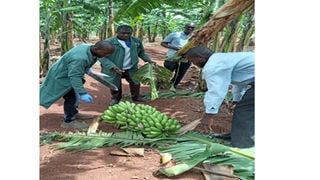
Officials at Bulindi Zonal Agricultural Research and Development Institute (BuZARDI) inspect a bunch of bananas on Friday last week. Photo/Lominda Afedraru
|National
Prime
Scientists breed bananas rich in vitamin A, iron
What you need to know:
- Some 28 percent of Uganda’s preschool-age children and 23 percent of pregnant women are deficient in vitamin A and iron, according to World Bank statistics.
Scientists at the National Agricultural Research Laboratories (NaRL) say they have developed bananas rich in vitamin A and iron.
The research is being conducted at the Mbarara Zonal Agricultural Research And Development Institute (MbZARDI), Bulindi Zonal Agricultural Research and Development Institute (BuZARDI), NaRL, and Buginyanya Zonal Agricultural Research And Development Institute (BugiZARDI) facilities.
The scientists said the bananas were performing well.
Scientists began breeding the bananas in 2010 to address the challenges of lack of nutrients in food.
Addressing journalists at MbZARDI on Friday last week, the trial site manager, Mr Isaac Magumba, said the scientists determined that a number of rural communities, particularly in western Uganda, are deficient in vitamin A and iron.
Mr Magumba said the most affected areas include Sheema, Mitoma, Rubirizi, Buhweju and Bushenyi, among others.
He added that the scientists felt that it was better to incorporate vitamin A into food which can be grown by the affected communities and consumed directly rather than encouraging pregnant women and mothers to buy vitamin A and iron tablets.
He said their research has shown promising results, with the transgenic banana variety having 100 percent vitamin A content. The fortified variety has a more golden colour when compared with ordinary bananas.
Mr Magumba said they are currently conducting multi-locational trials.
Research
The team accessed genes with beta carotene from non-edible bananas obtained from Papua New Guinea in Southeast Asia.
These were isolated and introduced through genetic engineering to two local cultivars, Nakitembe and M9, commonly known as Kiwangazi, mainly used for processing juice.
There were initially 800 lines at NaRL confined field trials. The team selected two lines with traits similar to those of the conventional variety but also with enhanced vitamin A properties.
The team checked the vitamin content using molecular methods in the laboratory that confirmed vitamin A content in the new banana varieties.
Further confirmation came from the field trial sites because the flesh of the fortified banana is orange in color. There is also an orange color expression deep in the leaves, meaning the gene inserted is fully integrated to the plants.
The existing vitamin A content in local banana varieties is 3-6 micrograms but the current selected varieties contain 35 micrograms suitable for human health.
The team has also ensured that the banana plant grows true to the traditional type with the initial traits remaining intact apart from introduction of vitamin A gene.
“When conducting the research, we consider the yield rate and we are harvesting bunches that weigh 50kg, pest and disease challenge, stability of the plant. We planted in January 2020 and we keep harvesting every seven months,” Mr Magumba said.
The trial manager at BuZARDI, Mr Julius Kaheru, said the yield at his site is not the same like in Mbarara because the land is infertile.
These banana varieties are ready for release to farmers but the challenge is scientists are still reworking the law to enable aspects of health to be incorporated.
Once the law is in place the selected varieties will be sent to the Variety Release Committee at the Ministry of Agriculture for onward certification.
Farmers speak out
Mr Johnson Agondeze Ntairawo, a resident of Bulindi Kigungu, said he appreciates the work the scientists are doing.
He said the yields on his farm are not uniform since in the first planting season. In a week he harvests 20-30 bunches of bananas in the first year but in the fourth year it reduces to five.
Another farmer, Mr Kenneth Kagezi, said he wants to venture into commercial banana farming.
He urged the researchers to release the new variety of bananas soon.




